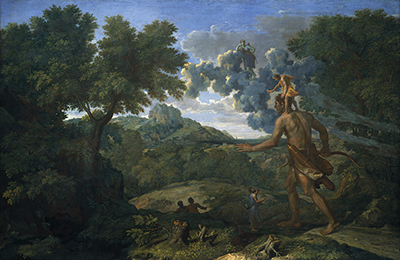Nicolas Poussin was a great classical French artist of the 17th century born in 1594. His work was full of beauty and so much logic and he spent most of his life working on mythological and landscape pieces.
He worked mostly in Rome and he had a privilege to work for some of the important people such as Louis XIII and Cardinal Richelieu. In 1658, he painted Blind Orion searching for the rising sun. In this painting he tries to bring visual picture of a blind giant huntsman (Orion) being directed on the way to follow in search of light by a cedalion on his shoulders. Around him there are men and a woman, who seemed to have normal sight. We cannot clearly describe where he is heading to but it seems like he is heading towards the horizon. This painting depicts his landscape talents that he describes in a rather poetic way that gives a room for a lot of discussion as it challenges our way of description. This art has the following dimensions: 46 7/8 by 72 in. (119.1 by182.9cm), using oil on canvas medium and it is located in Metropolitan Museum of Art.
He was born in Normandy, France and contrary to his parents desire he had an interest in art and in 1612 he ran from home to Paris where he arrived during the legacy of Marie de Medice when art was starting to thrive. He worked in several studios with different painters such as Ferdinand Elle. He was commissioned by Giambattista Marino who was a court poet to work on a series of fifteen drawings and he invited him to Rome in 1623. This was a breakthrough for him since he had tried to travel to Rome several times earlier without success. He arrived in Rome in 1624 during the era of pope Urban VIII and he could go to churches to examine the work of Raphael who had a great influence in his style. He became friends with other artists and with the help of Marino he got to meet various people such as Cardinal Francesco Barberini.
In Rome he received commissions to paint several pieces including the Martyrdom of St. Erasmus which made him a prominent painter. He was well known in Rome and he later returned to France to serve as first painter to King Louis XIII. In 1642, he returned to Rome where he spent his last years and he influenced several people such as:
- Andre Felibien who was his painting student and secretary to France embassy in Rome
- Charles le Brun whose working style he influenced later
He stayed in Rome where he worked on many pieces including his favourite, The Judgement of Solomon, and he died in 1665.




